|
 |
|
|
A Brief History of Red Cross Clubmobiles
in W.W. II
by Elma Ernst Fay U.S.R.C. (ret.) |
|
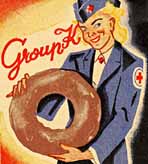 |
|
In World War II the American Red Cross was asked
by the U.S. Armed Forces to provide recreational services to the servicemen
in the various theatres of operation.
In Great Britain, the Red Cross began setting
up service clubs in London and towns near army installations. Shortly thereafter,
on air bases, aero clubs were set up. Because of the great difference in pay
between American servicemen and their counterparts from other countries, as
Great Britain, the army asked the Red Cross to make nominal charges for food
and lodging. |
|
|
|
|
|
|
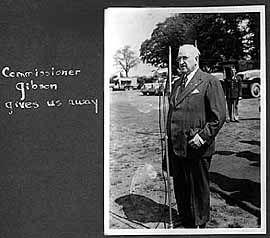 |
|
|
|
|
|
The
Red Cross clubmobile was conceived by the late prominent New York banker,
Harvey D. Gibson, Red Cross Commissioner to Great Britain, who wanted to
put a service club "on wheels" which would reach the serviceman at his camp
or airfield. Also, by having a club on wheels, the Red Cross was able to
get around the army's request that servicemen pay for food. Everything distributed
on a clubmobile was free. |
|
|
|
|
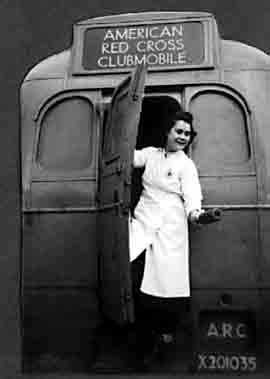 |
|
|
|
|
|
|
The
clubmobile in Great Britain was a remodeled London Green Line bus that could
be taken to the airfields and camps. Driven by an English driver, three
American girls were assigned to each clubmobile. |
|
|
|
|
The
clubmobile consisted of a good-sized kitchen with a built-in doughnut machine.
A primus stove was installed for heating water for coffee, which was prepared
in 50-cup urns. On one side of the kitchen area, there was a counter and
a large flap which opened out for serving coffee and doughnuts. In the back
one-third of the clubmobile, was a lounge with a built-in bench on either
side (which could be converted to sleeping bunks, if necessary), a victrola
with loud speakers, a large selection of up-to-date music records, and paperback
books. |
|
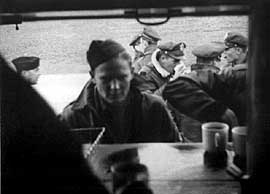 |
|
|
|
|
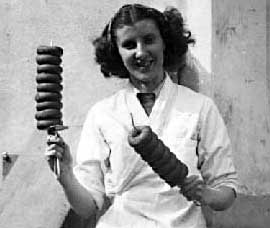 |
|
The
American girls who chose this service were taught to make the doughnuts
and coffee in the clubmobile. They were sent to a town near American army
installations, and followed a routine of going to a different base each
day, hooking up at a mess kitchen, making hundreds of doughnuts and preparing
coffee, and then driving around the base, serving the men at their work.
They also distributed cigarettes, life savers and gum, and had the loud
speakers tuned up for each stop. |
|
|
|
|
Clubmobiles
began operation in Great Britain in late 1942, eventually covering some
thirty bases and docks at Liverpool, Greenoch, Scotland, and Belfast, Ireland. |
|
|
|
|
|
|
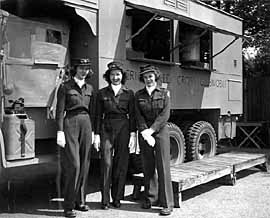 |
|
In
preparation for the invasion of Normandy, June, 1944, a smaller, 2-1/2-ton
GMC truck was converted to a clubmobile, with the necessary kitchen containing
doughnut machine, coffee urns and the like. Close to one hundred of them
were made ready. Red Cross girls who had worked on the larger clubmobile
in Great Britain, were given driving instruction in order to manage the
truck clubmobile. |
|
|
|
|
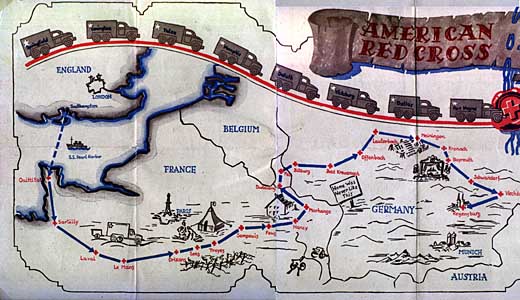 |
|
|
|
|
|
The route
of Group K, one of ten Clubmobile Groups accompanying American troops in
Europe |
|
|
|
|
|
|
|
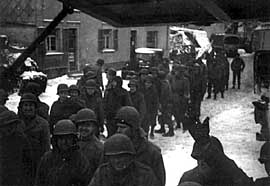 |
|
Beginning in July, 1944, as soon after the invasion
that it was safe to send Red Cross personnel onto the Continent, ten groups
of 32 Red Cross girls each, along with eight clubmobiles per group, a cinemobile,
three supply trucks, trailers and three British Hillman trucks, were sent
to France to be attached to various US Army Corps. |
|
|
|
|
Each
clubmobile group traveled with the rear echelon of the army Corps and got
its assignments from the army for serving troops at rest from the front.
The service continued through France, Belgium, Luxembourg and Germany, until
V-E Day, May 7, 1945. |
|
|
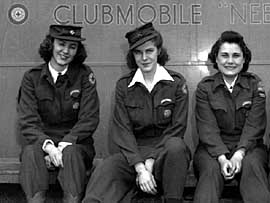
Group K Clubmobilers Charlotte Colburn, Marianne Shellabarger
and Elma Ernst, Leicester England 1944 |
|
|
|
|
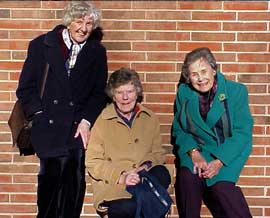
Former Group K Clubmobilers in January 2000:
Charlotte Colburn Gasperini, Marianne Shellabarger Jeppson, Elma Ernst Fay |
|
|
|
 |
|
|
A limited service continued during these months
in Great Britain, and after the war, for a year in occupied Germany.
--Elma Ernst Fay ll/15/00 |
 |
 |
 |
 |
 |
 |
 |
 |
 |









